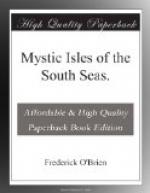Tahiti was the living Utopia of More, the belle ile of Rousseau, the Eden with no serpent or hurtful apple, the garden of the Hesperides, in harmony with nature, in freedom from the galling bonds of government and church, of convention and clothing. The reports of the English missionaries of the nakedness and ungodliness of the Tahitians created intense interest and swelled the chorus of applause for their utter difference from the weary Europeans. Had there been ships to take them, thousands would have fled to Tahiti to be relieved of the chains and tedium of their existence, though they could not know that Victorianism and machines were to fetter and vulgarize them even more.
Afterward, when sailors mutinied and abandoned their ships or killed their officers to be able to remain in Tahiti and its sister islands, there grew up in England a literature of wanderers, runagates, and beach-combers, of darkish women who knew no reserve or modesty, of treasure-trove, of wrecks and desperate deeds, piracy and blackbirding, which made flame the imagination of the youth of seventy years ago. Tahiti had ever been pictured as a refuge from a world of suffering, from cold, hunger, and the necessity of labor, and most of all from the morals of pseudo-Christianity, and the hypocrisies and buffets attending their constant secret infringement.
One morning when we were near the middle of our voyage I went on deck to see the sun rise. We were that day eighteen hundred miles from Tahiti and the same distance from San Francisco, while north and west twelve hundred miles lay Hawaii. Not nearer than there, four hundred leagues away, was succor if our vessel failed. It was the dead center of the sea. I glanced at the chart and noted the spot: Latitude 10 N.; Longitude 137 W. The great god Ra of the Polynesians had climbed above the dizzy edge of the whirling earth, and was making his gorgeous course into the higher heavens. The ocean was a glittering blue, an intense, brilliant azure, level save for the slight swaying of the surface, which every little space showed a flag of white. The evaporation caused by the blazing sun of these tropics made the water a deeper blue than in cooler latitudes, as in the Arctic and Antarctic oceans the greens are almost as vivid as the blues about the line.
I watched the thousand flying-fishes’ fast leaps through the air, and caught gleams of the swift bonitos whose pursuit made birds of their little brothers. Then, a few miles off, I saw the first vessel that had come to our eyes since we had sunk the headlands of California more than a week before. She was a great sailing ship, under a cloud of snowy canvas, one of the caste of clippers that fast fades under the pall of smoke, and, from her route, bound for the Pacific Coast from Australia. The captain of the Noa-Noa came and stood beside me as we made her out more plainly, and fetching the glasses, he glanced at her, started, and said in some surprise:




